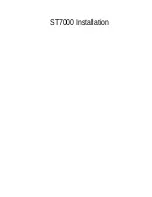
4- 9
Status Reporting
Status Byte Register
Example 1
This HP BASIC example uses the *STB? query to read the contents of the
oscilloscope’s Status Byte Register when none of the register's summary bits
are enabled to generate an SRQ interrupt.
10 OUTPUT 707;":SYSTEM:HEADER OFF;*STB?" !Turn headers off
20 ENTER 707;Result !Place result in a numeric variable
30 PRINT Result !Print the result
40 End
The next program prints 132 and clears bit 6 (RQS) of the Status Byte Register.
The difference in the decimal value between this example and the previous one
is the value of bit 6 (weight = 64). Bit 6 is set when the first enabled summary
bit is set, and is cleared when the Status Byte Register is read by the serial poll
command.
Example 2
This example uses the HP BASIC serial poll (SPOLL) command to read the
contents of the oscilloscope’s Status Byte Register.
10 Result = SPOLL(707)
20 PRINT Result
30 END
Use Serial Polling to Read the Status Byte Register
Serial polling is the preferred method to read the contents of the Status Byte Register
because it resets bit 6 and allows the next enabled event that occurs to generate a
new SRQ interrupt.
Summary of Contents for Infiniium 8000A
Page 1: ...Agilent Technologies Infiniium 8000A Programmer s Reference ...
Page 2: ......
Page 20: ...Contents 16 ...
Page 21: ...1 Introduction to Programming ...
Page 43: ...2 LAN and GPIB Interfaces ...
Page 53: ...3 Message Communication and System Functions ...
Page 58: ...3 6 ...
Page 59: ...4 Status Reporting ...
Page 78: ...4 20 Figure 4 3 Status Reporting Decision Chart ...
Page 79: ...5 Programming Conventions ...
Page 84: ...5 6 Programming Conventions The Command Tree Figure 5 1 Command Tree ...
Page 85: ...5 7 Programming Conventions The Command Tree Figure 5 2 Command Tree Continued ...
Page 86: ...5 8 Programming Conventions The Command Tree Figure 5 3 Command Tree Continued ...
Page 87: ...5 9 Programming Conventions The Command Tree Figure 5 4 Command Tree Continued ...
Page 88: ...5 10 Programming Conventions The Command Tree Figure 5 5 Command Tree Continued ...
Page 89: ...5 11 Programming Conventions The Command Tree Figure 5 6 Command Tree Continued ...
Page 94: ...5 16 ...
Page 95: ...6 Sample Programs ...
Page 149: ...7 Acquire Commands ...
Page 176: ...7 28 Acquire Commands SRATe AUTO ...
Page 177: ...8 Bus Commands ...
Page 187: ...9 Calibration Commands ...
Page 195: ...10 Channel Commands ...
Page 223: ...11 Common Commands ...
Page 247: ...12 Digital Commands ...
Page 254: ...12 8 ...
Page 255: ...13 Disk Commands ...
Page 300: ...13 46 Disk Commands STORe Obsolete ...
Page 301: ...14 Display Commands ...
Page 322: ...14 22 ...
Page 323: ...15 External Trigger Commands ...
Page 343: ...16 Function Commands ...
Page 382: ...16 40 ...
Page 383: ...17 Hardcopy Commands ...
Page 391: ...18 Histogram Commands ...
Page 403: ...19 InfiniiScan ISCan Commands ...
Page 421: ...20 Limit Test Commands ...
Page 429: ...21 Marker Commands ...
Page 452: ...21 24 ...
Page 453: ...22 Mask Test Commands ...
Page 499: ...23 Measure Commands ...
Page 636: ...23 138 Measure Commands VUPPer ...
Page 637: ...24 Pod Commands ...
Page 642: ...24 6 ...
Page 643: ...25 Root Level Commands ...
Page 645: ...25 3 STORe SETup STORe WAVeform TER Trigger Event Register VIEW ...
Page 674: ...25 32 ...
Page 675: ...26 Self Test Commands ...
Page 679: ...27 System Commands ...
Page 694: ...27 16 ...
Page 695: ...28 Time Base Commands ...
Page 708: ...28 14 ...
Page 709: ...29 Trigger Commands ...
Page 822: ...29 114 ...
Page 823: ...30 Waveform Commands ...
Page 893: ...31 Waveform Memory Commands ...
Page 902: ...31 10 ...
Page 903: ...32 Error Messages ...
Page 914: ...32 12 ...
















































